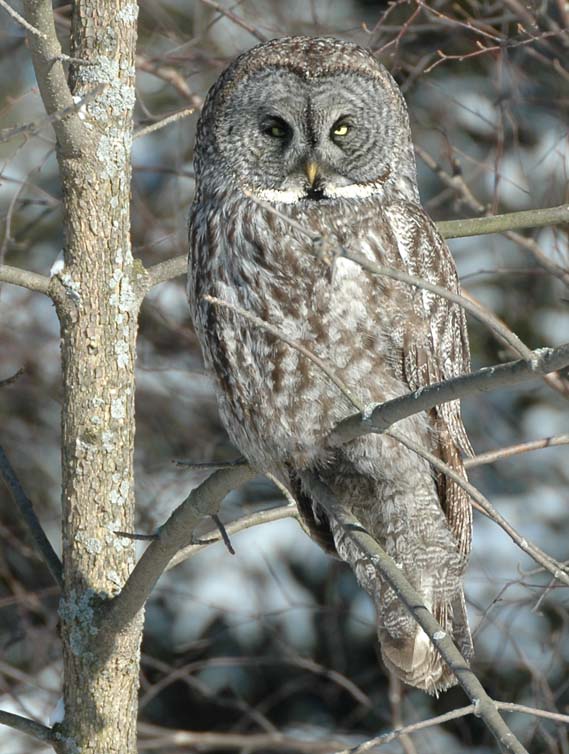Great Grey Owl (Strix nebulosa) - Wiki Great Grey Owl
From Wikipedia, the free encyclopedia
[Photo] Great Grey Owl. Here we see a Great Grey Owl venturing further south than usual in the Winter of 2004/2005. Taken by jok2000 http://en.wikipedia.org/wiki/User:Jok2000 January 22, 2005 in Whitby, Ontario, Canada
The Great Grey Owl or Lapland Owl (Strix nebulosa) is a very large owl.
They breed in North America from Lake Superior to the Pacific coast and Alaska, and from Scandinavia across northern Asia. They are permanent residents, but may move south and southeast when food is scarce. A small population, estimated at less than 100 birds, occurs in the Sierra Nevada mountains of California. This population is the southernmost population of the species range.
Their breeding habitat is dense coniferous forest near open areas, such as meadows or bogs. Great grey owls do not build nests, so typically use nests previously used by another large bird, such as a raptor. They will also nest in broken-top trees and cavities in large trees. Four eggs is the usual clutch.
The Great Grey Owl is 61???84 cm (24???33 in) in length, averaging 72 cm (28 in) for females, 69 cm (27 in) for males. The wingspan is up to 152 cm (60 in) averaging 142 cm (56 in) for female, 140 cm (55 in) for males. The adult weight is 790???1454 g (28???51 oz) averaging 1,390g (49 oz) for females, 1,290 g (45½ oz) for males.
Adults have a round head with a grey face and yellow eyes with darker circles around them. The underparts are light with dark streaks; the upper parts are grey with pale bars. This owl does not have ear tufts.
These birds wait, listen and watch for prey, then swoop down; they also may fly low through open areas in search of prey. They mainly eat small mammals, with voles being their most important food source, and sometimes small birds. In California, gophers provide important secondary prey when vole populations are low. On the nesting grounds, they mainly hunt at night and near dawn and dusk; at other times, they may be active day or night. They have excellent hearing and may capture prey moving beneath the snow. Their large facial disks focus sound, and the asymmetrical placement of their ears assists them in locating prey.
Captive birds have been known to live as long as 40 years. Mortality in the wild is mostly due to starvation. These birds have no fear of vehicles, hence are often victims of collisions when they venture into populated areas seeking food.
The male's call is a series of very deep whoos.
Trivia
This is the provincial bird for the Canadian province of Manitoba.
In the Harry Potter series of children's books, the Weasley family owl, Errol, is a Great Grey.
http://en.wikipedia.org/wiki/Great_Grey_Owl
| The text in this page is based on the copyrighted Wikipedia article shown in above URL. It is used under the GNU Free Documentation License. You may redistribute it, verbatim or modified, providing that you comply with the terms of the GFDL. |
